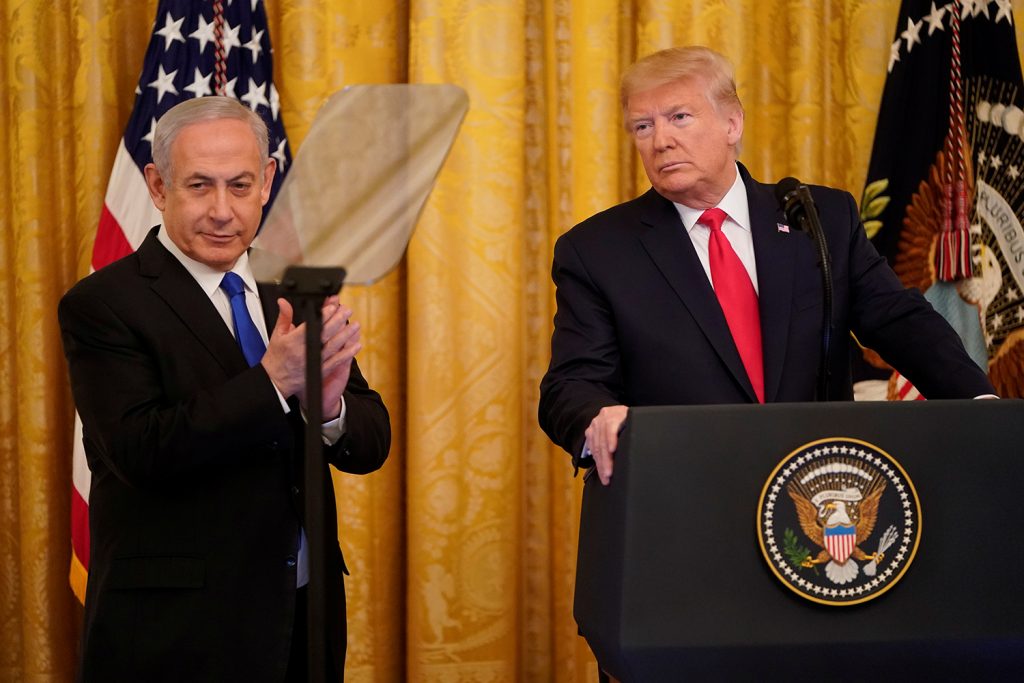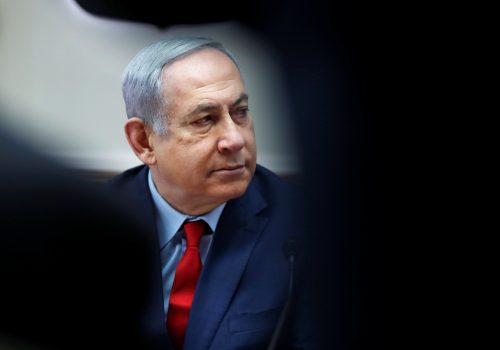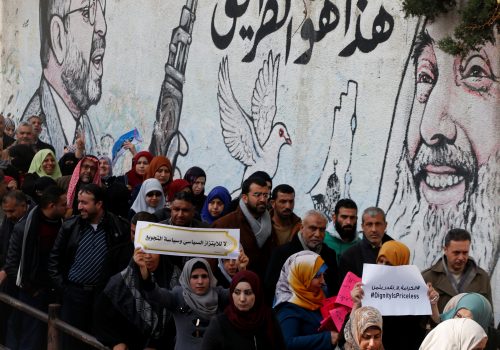President Donald J. Trump released his long-awaited Israeli-Palestinian peace plan at the White House on January 28, alongside Israeli Prime Minister Benjamin Netanyahu. The much-anticipated “Deal of the Century,” which had been in the works for three years, came complete with one hundred and eighty pages as well as a map outlining the proposed new Israeli and Palestinian states.
Under its terms, Israel would annex settlement blocs in the Jordan Valley as a condition for a contiguous Palestinian state in the West Bank and Gaza over twice the size of the territory now administered by the Palestinian Authority. The plan also ensures Israeli control over an undivided Jerusalem—long a contentious issue in the peace process—but does not preclude a Palestinian capital in East Jerusalem. The Palestinian leadership had previously voiced its opposition to the deal and is expected to reject it emphatically, alleging bias toward the Israeli side.
Following Trump’s remarks, Netanyahu endorsed the deal as a basis for negotiations with the Palestinians. Benny Gantz, leader of the opposition Blue and White Party, met separately with Trump on January 27 and also praised the plan, which he vowed to implement should he succeed Netanyahu as prime minister. Amid a political stalemate in Israel in which no party has been able to form a government, Israelis will head to the polls on March 2 in the country’s third election in under a year.
Atlantic Council experts react to the announcement of the Trump administration’s peace plan:
William F. Wechsler, director of the Rafik Hariri Center and Middle East Programs at the Atlantic Council:
“The announcement’s chosen timing, specific staging, limited participants, and indeed its substance make clear that it has less to do with a good faith effort to reach peace between Israelis and Palestinians, and more to do with the immediate legal and electoral challenges that confront both leaders. In the short term, the plan is unlikely to have a major impact, either in reviving a moribund peace process or in driving a surge of political support for President Trump or Prime Minister Netanyahu.”
“But over the longer term this plan, and the manner in which it was announced, risks reinforcing a number of negative trends for the US-Israel relationship. It risks encouraging the more extreme voices within the Israeli political spectrum and does nothing to encourage the next generation of potential Palestinian leadership. It risks further polarizing the US-Israeli relationship within US politics, slowly transforming longstanding bipartisan support for Israel into yet another partisan domestic wedge issue—something that for many decades Israeli leaders sought to prevent.”
“For some supporters of the administration’s approach, these risks are precisely the objective. Other supporters privately acknowledge these risks but argue they can be managed and that the plan is nevertheless worthwhile because it will effectively reset the baseline of the peace process by challenging certain underlying assumptions that have prevented progress to date. Of course, that assumes that future US presidents will feel bound by the change in policy that this plan represents. Unfortunately, while once it was unthinkable for US presidents to casually reverse national commitments made by their predecessors, especially when it comes to complicated questions of Middle East peace and security, it is now becoming increasingly normalized. Indeed, this is a particularly prominent element of the Trump administration’s approach across the region.
The sad irony is that the peace process desperately needs new ideas, even if the ideas revealed today and the means by which they were developed and announced were not ideal. And given the longstanding positions taken by the current Israeli and Palestinian leaders, the only credible source for those new ideas is the United States. Too many Israelis believe time is on their side because of the current status quo is perceived to be infinitely extendable; too many Palestinians believe time is on their side because of their demographic growth. Unfortunately, both can’t be right over the long run. The current path, in the absence of a credible peace process, leads inexorably to a terrible choice between a Jewish minority trying to indefinitely rule over an Arab majority, or the kind of violent catastrophe that changes the demographics of the area. Neither of these scenarios should be acceptable to any side.”
James B. Cunningham, nonresident senior fellow with the Atlantic Council’s South Asia Center. He is a former US ambassador to Afghanistan, Israel, and acting permanent representative to the United Nations.
“It would seem that the Trump “peace plan” is a combination of most of what the Netanyahu government and many Israelis would like to see, and a presentation at the outset of a very limited version of that to which Palestinians aspire. It is in its essence a projection of what this administration proposes the Palestinians must accept for “peace.” It is not a basis for a negotiation, which is most unlikely in any event given the state of both Israeli and Palestinian politics. The notion of two states is only barely and sparely preserved, and the idea that a settlement “freeze” in some parts of the West Bank can facilitate a solution is fraught with difficulty, given past history. Most importantly, President Trump with this “plan” will sharpen the debate over whether Israel is destined to maintain indefinitely an occupation of the West Bank in the eyes of most of the world, and in the end arrive at a de facto or de jure one-state solution.”
Kirsten Fontenrose, director of the Scowcroft Center for Strategy and Security’s Middle East Security Initiative:
“Governments in the Middle East will not speak with a unified voice about the peace plan. Oman, Bahrain, and the UAE signaled their willingness to get behind the plan by having their ambassadors present at the plan rollout. Their presence is consistent with stances each government has taken prior to and separate from the peace plan itself.
“Oman welcomed Netanyahu in the fall of 2018 in a bold, tangible demonstration of Oman’s national mantra “friend to all.” Omani Foreign Minister Yousef bin Alawi gave ongoing counsel to the team at the White House throughout the plan’s development and was always warmly welcomed. Ambassador Hunaina al-Mughairy’s attendance at the rollout indicates that the new Sultan will continue to support the peace effort, should it continue.
“By sending Ambassador Sheikh Abdullah bin Al-Khalifa to the rollout, Bahrain answered questions about whether the country will diverge from its previous Israel-friendly statements under new Foreign Minister Zayani. The speeches today by President Trump and PM Netanyahu were the first public event related to the wider region hosted by the US Government since the King announced earlier this month that Gulf Cooperation Council (GCC) Secretary General Zayani will replace Foreign Minister Khalid bin Ahmed Al-Khalifa, much loved in US Government circles, beginning in April.
“The Emiratis enjoy a close relationship with the White House and supporting the rollout of the plan is meant to keep it that way. At a time when the United States looks unfavorably at UAE benefactor Khalifa Haftar’s alignment with Russia in Libya and at the presence of an Emirati embassy in Syria, this is shrewd. It is also consistent with the Emirates’ observation of 2019 as the Year of Tolerance.
“In a real-world example of “my enemy’s enemy is my friend”, the UAE, Saudi Arabia, and Bahrain share a regional adversary with Israel. Iran’s sponsorship of violent proxies has impacted each of these Gulf countries and has unwittingly and ironically driven them into the arms of Iran’s sworn enemy, Israel. These states are discovering that there could be much to gain from cooperation on cyber, limited intelligence sharing, and possible energy network and trade market expansion.
“Kuwait will adopt a wait-and-see approach. The country has been the most hesitant of GCC members to lend support to the peace plan effort. The emir of Kuwait is always in favor of peacefully resolving regional disputes and spares no effort in the service of repairing relations among Gulf neighbors. But Kuwait has refrained from expressing outright support for the White House initiative, saying they would need to see the plan before they could comment.
“Qatar has steadfastly reiterated that any plan accepted by the Palestinians will have their backing. This has been a reminder to the administration that a plan benefitting only Israel would not be rubber-stamped by the close partner nation. But with the ongoing Gulf rift, Qatar can’t risk being too far flung from US policy. Qatar worked consistently to try to bring the Palestinians to the table for negotiations on the peace plan and socialized with the White House their financial support to the Palestinian Authority.
“Egypt also strove to bring Palestinian representation into the build of the plan. The Egyptian government must balance fears over the reaction of its Muslim citizens to a plan deemed unfair to coreligionists with fears of the threat of cross border weapons and people smuggling that could result from a porous border insufficiently monitored by a new Palestinian state. Thus, the buffer strip that appears on the proposed map.
“Ever-patient Jordan must be taking a deep breath and hoping sentiments enflamed over the very idea of the plan do not boil over into unrest. Jordan needs stability as it struggles to put flesh on the bones of its economy, so Jordan has done everything possible to be encouraging of the US administration’s process of developing the plan, while trying hard to convey and clarify the redlines it hears in its streets.
“We can expect all members of the GCC plus Egypt and Jordan to encourage Palestinian parties to approach the proposed plan as a new starting point for negotiation. If seen as such, it offers more than most watchers of this conflict would expect. The requirements laid out in the preamble can be bargaining chips as much as obstacles. Four years allows time for confidence building measures. Stop the payments to the families of “martyrs” in exchange for social services for all widows and orphans, for example. Negotiate tax rates to be paid by Israeli settlers in a new Palestinian state. Expanded territory in exchange for meeting reduction in violence metrics in two versus four years.
“The plan is not presented as a fait accompli. If Palestinian parties can agree among themselves to interpret this rollout as a basis for negotiation, they are free to respond with proposed edits. Any discussion beats the current stalemate. The risk Palestinians take in not addressing the plan with serious thought and strategy is that the issue of their fate will be swept from the world stage, the eyes that can hold Israel accountable will turn elsewhere, and until Iran no longer poses a threat to the region with proxies, missiles, and the threat of nukes, larger concerns will bind its allies to its enemy.”
Frederic C. Hof, distinguished fellow and former director of the Rafik Hariri Center and a former US special envoy to Syria:
“For the United States to put a plan on the table to achieve a mutually agreed end to Israeli-Palestinian conflict is not a hanging offense. I have favored the tabling of a US peace template for decades, and actually did so in the context of a once promising Israel-Syria peace mediation in 2010-11. The Trump administration does not merit condemnation for putting in writing its vision of a Palestinian-Israeli peace agreement, one ideally resulting in the long-sought two state outcome.
“What comes next, however, is vitally important. Washington should make clear its willingness and readiness to help the parties reach an outcome that is mutually agreeable. Unilateral annexations and the like should be discouraged. If they are not, the four-year timeframe for implementation will, as was the case with far-out deadlines associated with the Oslo process, become an incubation period for destabilization and violence.”
“Much depends also on the Palestinian reaction over the long-term. Obviously, the leaders of the Palestinian Authority, the Palestine Liberation Organization, and Hamas are united in seeing the US peace prescription as pure poison. Still, non-stop denunciation and an adamant refusal to engage diplomatically will not serve the interests of the Palestinian people: refugees and residents alike. As difficult as it may be given Palestinian political weakness and disorganization, there is no substitute for diplomatic engagement informed by careful deliberation and sober strategizing. Perhaps parties as diverse as the European Union, Canada, and Jordan can assist Palestinian leaders in organizing a diplomatic effort aimed at achieving an end-state more in keeping with traditional Palestinian permanent status goals.
“No doubt those who designed the ‘deal of the century’ are pleased with their work and gratified by Israeli Prime Minister Benjamin Netanyahu’s reaction to it. But the tabling of what one might label ‘the Trump Parameters’ is—or should be—the opening shot of an intense and long-term US diplomatic heavy lift. The goal remains as it was under previous administrations: two democratic states living in peace and security while engaging cooperatively.
“The Trump administration may go down in history as having rescued the two-state outcome from oblivion, but only if it succeeds diplomatically in bringing about an outcome that is mutually acceptable to the two peoples who count: Israelis and Palestinians.”
Carmiel Arbit, nonresident senior fellow with the Atlantic Council’s Middle East Programs:
“Today marks a historic agreement—between Israel and the United States, solidified by a handshake between Netanyahu and Trump rather than a handshake between the Israeli and conspicuously absent Palestinian leadership. The eighty-page plan has yet to be released but what is clear is the following: the United States and Israel will agree on borders—allowing for unilateral annexation in the West Bank. The Palestinians will then have the opportunity to pursue statehood based on those imposed terms.
“Never before has a US administration offered the Israelis so much, at such a low cost, or in such a way, and it comes as no surprise that Netanyahu has embraced the plan and the Palestinians have rejected it outright.”
“The full consequences of this agreement will take time to bear out. In the worst-case scenario, widespread violence could erupt in the Palestinian territories and Israel could move quickly to annex the Jordan Valley or parts of the West Bank. The precise areas annexed will have a significant impact on whether these measures foreclose on a future two-state solution entirely.”
“In the best-case scenario, the plan will be overtaken by political events and over time fade away, just as its economic companion has. It is important to remember that the announcement comes at a time of great uncertainty in both countries—coinciding with Trump’s impeachment trial, Netanyahu’s indictment, and elections on the horizon in both countries. In the United States, even the most centrist Democrats rejected the agreement before its release and could pursue calls for conditioning aid to Israel should they commence annexation. In Israel, opposition leader Benny Gantz has used a very clever sleight of hand to deflect support for an agreement, while Israel’s left has of course rejected it outright. Eyes now turn to the international community to respond—the Palestinians will rely on Jordan, Saudi Arabia, and European Union member states to shield them from the potentially dire consequences of the deal.”
Richard LeBaron, nonresident senior fellow with the Atlantic Council’s Middle East Programs:
“This plan seems consistent with the US administration’s approach of granting unilateral concessions to Israel while further isolating the Palestinians. The hope appears to be that the Palestinians will be pushed by circumstances (and by some Gulf states) into negotiating some variant of the plan, while Israel continues to consolidate its position. From what he said today, it seems that President Trump is pleased to have finally released the plan but harbors his own doubts about its viability.”
Masoud Mostajabi, an assistant director of the Middle East Programs at the Atlantic Council:
“This so-called historic peace plan is, at its core, a non-starter for Palestinians as it was rejected before it was ever revealed.
“The plan does not give Palestinians control of Haram al-Sharif (Temple Mount), preferring continuation of Jordanian Waqf administration, nor does it allow East Jerusalem to become Palestine’s capital, rather the ‘East Jerusalem’ outlined in this plan is relegated to the outskirts of the city. Furthermore, the plan grants Israel full control of all coastal waters and airspace, while effectively surrounding peculiar portions of what’s been identified as Palestinian land. There is also the issue of annexing the Jordan Valley and existing settlements, which have been identified as illegal under international law. The most significant piece offered to Palestinians is $50 billion in infrastructure investments, critical for its territories.
“Although the deal is clearly not fair, it does not seem as though it was ever intended to be. Rather, acknowledging the realities of a weak Palestine, in a region with declining Arab interest in the Palestinian cause and a turn toward anti-Iran unification.
“The United States should continue to fully support Israel in its security and defense. However, unless there is miraculous breakthrough from the Palestinian side in accepting this “deal of the century,” the way for the United States to successfully approach any Israel/Palestine issues or be a mediator in conflict resolution in the future, would be with some measure of balance and a willingness to put some serious pressure on Israel; the side the United States has the most sway over.”
Daniel J. Samet is a program assistant for Middle East Programs at the Atlantic Council.
Further reading:
Image: Israel's Prime Minister Benjamin Netanyahu applauds as he and U.S. President Donald Trump deliver joint remarks on a Middle East peace plan proposal in the East Room of the White House in Washington, U.S., January 28, 2020. REUTERS/Joshua Roberts



